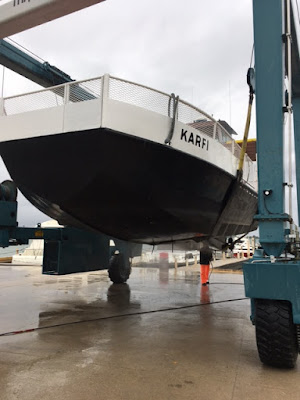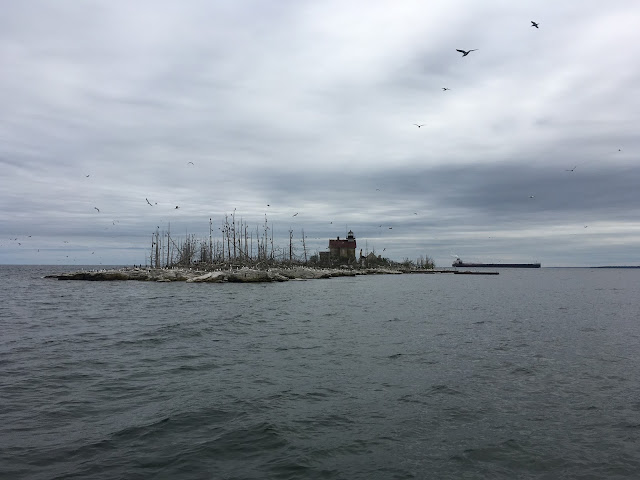 |
| Spring: Say it with flowers...or even pretty weeds. |
Washington Island, Wisconsin -
This posting will catch us up on a backlog of photos taken, considered at one point, and now put into play to represent a few activities of the past months.
While springtime is long awaited, a several month process in which only a handful of days would qualify as "warm and pleasant," the variety in our weather has to be considered for it's contribution to an exciting life on a northern island. Shown is the result of a spring snowstorm. (I've lost track, but I think it was in late March.) "Is it safe to put the shovel away?" we asked each other when that storm was over, meant as a joke but said with fingers crossed in the pocket of our heavy spring jacket.
 |
"It's pretty, at least." "It won't last long."
"We can use the moisture." All of these, and more,
are commonly issued Island sentiments, brave attempts to
cover up our disappointment in the long-awaited, true
spring experience. |
At a certain point, when construction was complete except for touch-ups, a new Northport ticket booth was towed by tractor down the Point road from an indoor shop, and made ready for installation at Northport. This project resulted in a larger, "deluxe" type booth that can more easily accommodate the public and host ticket seller, occasionally two at one time (two doors for egress, two stations, more windows facing traffic and ferries...).
The physical move to Northport and installation took place in one day's time, with removal of the old booth, reconnecting a phone line, laying a new electrical line, and filling and blacktopping the hole in the pavement where the old booth stood.
The new building is oriented with the intent to serve walk-up and drive-by traffic, without the one interfering with the other. Once on site, this booth was also leveled to improve the equilibrium of the employees who stand within for hours during each shift. (The old booth sloped downward with the existing pavement.)
Since installation we've even had our first scrape, a light sideswipe by a truck that turned too abruptly toward the ferry. Large stones,or other dense barrier material may soon be installed to offer better booth protection.
Below, the new booth is shown on the foredeck of the
Eyrarbakki the day prior to installation, as final touches were made.
1961 Packer Ball
Purinton family members, 15 in all, were present at the Green Bay Packers Hall of Fame April 8, to present a 1961 Championship Team football.
As donors, we were guests of the Hall of Fame for lunch in the new restaurant, "1918," and for the ceremony that followed, all of which was set up through calls and correspondence over a several month period of time.
The ball was given to my father, Harry F. Purinton, at a BarberShoppers (a singing organization) district conference in early May, 1961. Featured speaker at the convention dinner was Packer quarterback Bart Starr, who then passed this autographed ball to Dad, recognized for his work at local and district level (Wisconsin, parts of Illinois and Minnesota, and the Upper Peninsula) in the organization. At the time, he served as Chapter President of the Baylanders Chorous, in Green Bay.
So, this football has been in our family, on a shelf mostly, for the past 54 years. Mostly by good fortune, the panels of the ball with signatures of both coaches and players were away from the window sunlight, and they and the ball are quite well-preserved. This is the reason this ball was welcomed by the Hall of Fame. That, and the fact that each player on the team except one, who perhaps wasn't available then, signed the ball. Out of 44 signatures, 28 men were later named to the Packers Hall of Fame. And of those total players and coaches, 12 men were named to the NFL Hall of Fame.
The authenticity of the ball was never in question, but to be sure, two Board Members of the Hall of Fame closely inspected the ball several weeks prior to its transfer. One unique mark that is used to determine the authenticity is the name Red Cochrane, a Packers coach who used the "R" in the ball trademark as a part of his name. Stamped or imprinted balls made at a later time don't have that distinctive signature characteristic.
 |
Nephew John and Hoyt Purinton pose next to the
Hall of Fame display case featuring the recently
donated football. (Paul Hornung's square-toed
kicking shoe is adjacent, off-screen to the right.) |
Of course, this was not only a great day to enjoy, but it was also one of a very few times in recent years so many family members have come together. Nephew Ben Bacon came from Shanghai, China, in part for a memorial service for his father, for his mother, Helen's, 70th birthday, but also to join in the event. Ben noted that one of the very few "sports bars" in Shanghai is only a few blocks away from his apartment, and Packer fans from the area (and there are quite a few of them) get together at 5 am at this known Packer sports center. That is the time when the games are typically broadcast live on television there. A wide net is cast by Packer supporters around the world!
We are thrilled to have in our midst two family bakers: Chad Beneda and Aidan Purinton. Both of these fledgling bakers brought their wares for tasting at a family gathering. Chad brought a sourdough bread, full-bodied, delicious fresh or toasted. Aidan, who has taken a shine of late to all things related to kitchen craft, especially multi-step dishes, has mastered Irish soda bread. A few weeks later, he designed, and prepared, a several course meal for his grandmother's birthday. Talk about lucky grandparents! Here is Aidan with his first loaf of Irish soda bread, just removed from the oven.
 |
| Add caption |
Finally, in the remaining space available (which, I think, is nearly infinite) we feature a March project in which the entry signs for the Island Terminal are touched up by yours truly. Sizing is first applied, then gold leaf, to brighten up lettering on these two signs that hang over the entry.
This June will mark the 20th year (already!) that this terminal building has been in operation, a milestone in improvement for customers, and for employees. Prior to this, all functions were out of the blue building on the dock, useful for many years, but at the end of its useful life as a ferry office and customer base.
One can hardly minimize the needs this building fulfilled: the storage records and shelving of small packages for a night or two; the public, and the employee, restroom facilities; a lobby; office space with a conference table; a customer desk that offers a visible presence for those who need information. It's been a great improvement, and yet, with the proliferation of small packages on the rise, thanks to Amazon, FedEx and other shippers, we may one day need to look at the possibility of expanding or improving these facilities.
Anyway, for those who don't yet know where they are, or what this building is, the signage has been brightened to attract their eye.
And with that, let's get on with spring, already!
Today's temperatures are in the lower 50s, and we've lost our sun since daybreak. A moderate breeze blows cool from the NE, off Lake Michigan. Trillium that began to open, joining daffodils and May flowers, may hold back another week or so before fully displaying their blossoms.
It's an Island spring, after all.
- Dick Purinton





















































